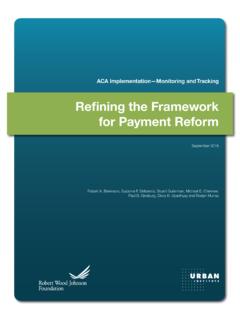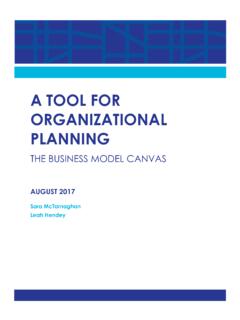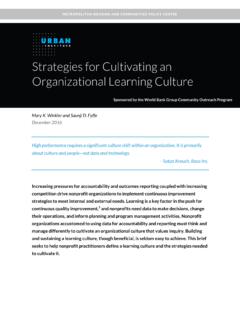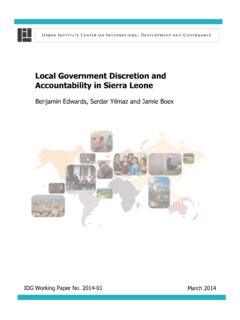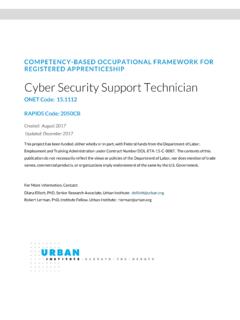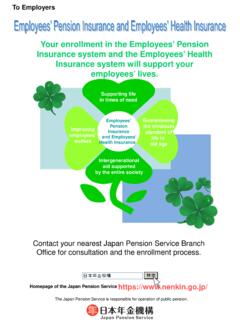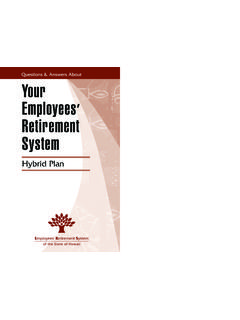Transcription of How Long Must State and Local Employees Work to …
1 Although traditional pension plans are fading away in the private sector, they still cover seven in eight full-time State and Local government Employees (US Bureau of Labor Statistics 2013). By offering lifetime retirement benefits based on service years and final average salaries, defined benefit pensions generally provide secure retirement incomes to workers who devote their entire careers to government service. These pensions provide little retirement income security, however, to most government Employees with shorter tenures, even many who spend 20 years with a single public-sector Virtually every plan requires participants to contribute toward the cost of their retirement benefits, and Employees must work many years before their future benefits exceed the value of their required contributions.
2 Those who leave public service before reaching that milestone do not receive any employer-financed retirement benefits, despite their often lengthy careers. Recent pension reforms, focused mainly on cutting costs, generally force new hires to work even longer before they benefit from their pension plans. Alternative benefit designs like cash balance plans would enable all State and Local government Employees to accumulate retirement savings, including those with shorter careers. This brief reports how long State and Local government Employees hired at age 25 must serve to earn any employer-financed pension benefits from their traditional plans.
3 The analysis identifies the first year that Employees could leave public employment with promised future pension payments worth more than their own plan contributions. We also examine how recent public pension reforms have altered when Employees first accumulate any employer-financed benefits. Results are based on the Urban Institute s State and Local employee pension Plan database, which provides detailed benefit rules for State -administered retirement plans covering teachers, police officers and firefighters, and general State and Local government Employees in all 50 states and the District of Columbia.
4 Page 5 details our methods. How Do Benefits Accumulate in Traditional Pensions? Traditional pensions pay annual retirement benefits equal to a specified percentage of final average salary typically calculated over the last three or five years of employment multiplied by completed years of service. Half of traditional State and Local plans provide benefits that replace at least 46 percent of the final year s salary for Employees who retire with 25 years of service. Retirement eligibility is usually tied to age and years of service. For age-25 hires, half of plans offer full benefits at age 55 or older.
5 Ninety percent of plans mandate employee contributions, now averaging 7 percent of salary. Traditional plan participants do not accumulate many future retirement benefits early in their career. Benefits for workers who separate early are based on the relatively low salaries they received at younger ages, not the higher salaries typically received at older ages. Additionally, Employees early-career plan contributions are worth more than the same amount contributed later, because they could have earned interest longer if invested outside the plan. As a result, the value of required plan contributions often exceed future pension benefits until participants have worked long enough to receive generous pensions.
6 Consider Employees hired at age 25 enrolled in a traditional plan that provides annual benefits equal to 2 percent of final average salary (averaged over the last five years) times years of service. Benefits vest after five years, meaning that Employees who complete less service do not receive any pension benefits. In this hypothetical (but typical) plan, Employees must contribute 7 percent of their salary to the plan each year and may begin collecting benefits at age 60. Benefits are adjusted each year after retirement to keep pace with inflation. Lifetime pension benefits in this hypothetical plan grow slowly early in a career (figure 1).
7 After 15 years of service, for example, Employees earning average salaries would accumulate $35,000 in future lifetime pension benefits (expressed in constant 2014 dollars). These Employees would receive annual payments equal to $15,000, replacing 30 percent of final average salary, but they would have to wait 20 years to begin collecting. By contrast, Employees plan contributions would be worth $60,000 after 15 years of service, about three-quarters more than the value of their future pension benefits. Those future pension benefits grow rapidly with additional service years, but in this example Employees must work nearly 25 years before their future benefits are worth more than what they have contributed.
8 How Long Must State and Local Employees work to Accumulate pension Benefits? Richard W. Johnson, Barbara A. Butrica, Owen Haaga, and Benjamin G. Southgate Public pension Project Brief 1 April 2014 2 URBAN INSTITUTE Shorter-Term Employees Often Get Nothing from Their pension Plans In half of the traditional plans administered by State governments, Employees must work at least 20 years before accumulating any employer-financed pension benefits (figure 2).2 Employees in those plans who separate with less than 20 service years are better off collecting a refund on their plan contributions than waiting to collect a pension at their plan s retirement age, so they effectively gain nothing from their retirement plan.
9 In half of plans covering public school teachers, it takes at least 24 years of service to earn any employer-financed pension benefits; in half of plans covering police officers and firefighters, it takes 18 or more service years. Only 19 percent of plans enable State and Local government Employees hired at age 25 to accumulate any employer-financed pension benefits within the first 10 years of employment, including only 14 percent of plans covering public school teachers (table 1). In more than a fifth of plans (22 percent) age-25 hires must work more than 25 years before their future pension benefits are worth more than their plan contributions.
10 Teachers have to work longer than other public Employees to earn employer-financed pensions. In nearly two-fifths of plans (39 percent) covering teachers, age-25 hires who leave before completing 26 years of service get nothing from their pension plans other than their own contributions. $0$50,000$100,000$150,000$200,000$250,00 0$300,000$350,000051015202530 Constant 2014 dollars Years of service Figure 1. Illustrative Lifetime pension Benefits and employee Plan Contributions for State and Local Government Employees Source: Authors' calculations from the Urban Institute's State and Local employee pension Plan database.
